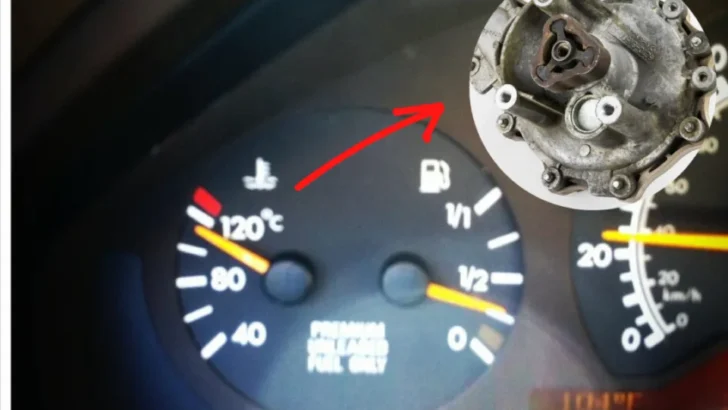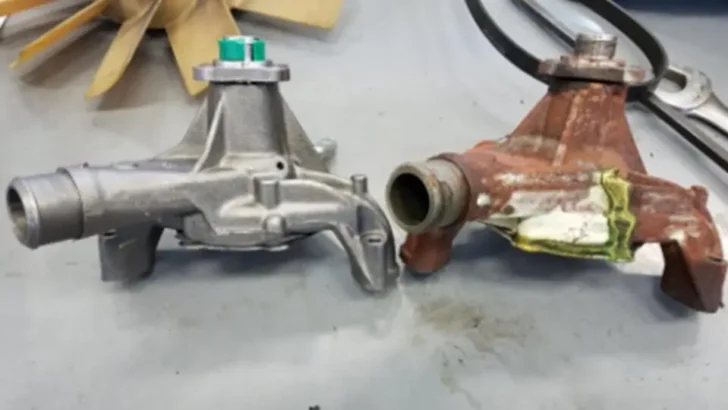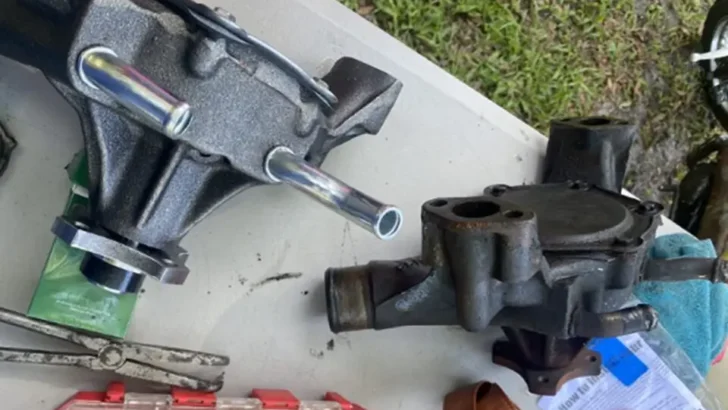There are a lot of components that can cause a car to overheat when they fail, but is the water pump one of them? The purpose of the water pump is to circulate the coolant through the engine. By doing so, it regulates the temperature of the engine. However, can a failed water pump cause the car to overheat since there are radiator fans that aid in cooling the engine?
Key Takeaway
- Bad water can cause the car to overheat because there will be no coolant circulating and absorbing the heat from the engine.
- A bad water pump will not leak when the car is off because all of the coolant returns back to the radiator when you turn off the vehicle.
- A bad water pump makes whirling noise which means the bearings inside have started to fail.
- You should replace the water pump every 60,000 to 100,000 miles.
- When the water pump starts to fail, it will often leak coolant through the weep hole when the vehicle is running.
Can a Water Pump Cause a Car To Overheat?

A bad water pump can cause a car to overheat because the main purpose of the water pump is to circulate the coolant through the engine and regulate the temperature to avoid engine overheating. When the water pump goes bad, there can be a disruption of the coolant flow rate which will most definitely lead to engine overheating.
Water pumps are driven by a pulley belt that engages when the engine is started. The moment you start the engine, the water pump engages and starts circulating coolant through the engine. When the engine is cold, the water pump is circulating coolant internally without allowing it to go to the overflow tank and cool off. This actually helps the engine to get to the operating temperature faster.
However, when the engine gets to the optimal working temperature, the coolant absorbs the heat and becomes hotter than the engine. Now, the water pump circulates the hot coolant to the radiator where it triggers the radiator cap to open a passage to the overflow there the coolant will cool down.
Without a properly working water pump, the coolant won’t be able to circulate through the engine and absorb its heat. The radiator fan will engage when the temperature will start to go over the optimal temperature. But, without coolant circulation, the radiator fan is helpless and the engine will overheat.
To avoid engine overheating, make sure to check your water pump every 30,000 miles and replace it every 60,000 miles. This way, you will not have to worry about your car overheating.
Does a Water Pump Leak When The Car Is Off?

No, a water pump can not leak coolant when the car is off because when you turn off the engine, all of the coolant goes back to the radiator. The only time a water pump can leak coolant is when the engine is turned on and the water pump is circulating the coolant.
The water pump is the heart of the cooling system. It starts when the engine is started because they are driven by the timing belt. Once the engine is started, the water pump immediately starts pulling out the coolant from the bottom of the radiator and circulates it through various passages inside the cylinder head and engine block.
When a water pump goes bad, it can simply stop pumping coolant, it can make a whirling noise suggesting that the bearings are going bad, or it can start to leak coolant. But in order for the water pump to leak coolant, it has to have coolant in it. And the only time a water pump has coolant in it is when it is running.
This is why it is impossible for a water pump to leak when the car is off. If your car is leaking coolant when the engine is off, you should look elsewhere. Check the cooling system hoses for cracks. Inspect the radiator. Take a look at the condition of the overflow tank.
What Noises Does a Bad Water Pump Make?

A bad water pump makes a whirling noise because the bearings inside the water pump start to fail, or the pulley attached to the water pump is loose and creates a back-and-forth motion that generates a whirling noise.
A perfectly working water pump isn’t producing any noise, or at least it isn’t producing any noise louder than the engine itself. This indicates that the moving parts of the water pump such as the impeller and the bearings are working properly.
A whirling noise coming from the engine bay is almost a certain sign that something is going on with the water pump. The noise starts as barely noticeable and gradually builds up to an unpleasant whirling noise that is louder than the engine.
The main reason why a bad water pump starts making a whirling noise is that the bearings inside the water pump are worn out. The bearings receive the power from the pulley and then transfer it to the impeller. If you take a look at the water pump bearings, you will see metal balls that are turning and twisting in order to do their job.
Basically, the water pump bearings are designed to reduce friction by having smooth balls and a smooth inner surface where the balls roll. As the pulley spins, the bearings receive that turning power and transfer it to the impeller without causing friction. However, when the bearings of the water pump start to fail, you will hear a whirring noise that is actually louder than the engine.
At What Mileage Does a Water Pump Need To Be Replaced?

Modern water pumps today are simple and very robust. However, like a lot of components, they eventually fail. The best mileage to replace a water pump is between 60,000 and 100,000 miles. There are some water pumps that will last over 100,000 miles, but it is just not worth the risk.
If you take your vehicle to the mechanic shop for regular maintenance, replacing the water pump is on the list. Now, I know that not all water pumps will last the same. This is why many mechanics say that water pumps last anywhere between 60,000 and 100,000 miles. The gap is huge because there are pumps that fail at 60k, and there are pumps that fail at 100k.
However, it is better to replace the water pump when it is due for replacement. Otherwise, you can be stranded on the side of the road with an overheating engine. Although the water pump can start showing signs of failure such as puddles of coolant on the floor, the engine running warmer than usual, or a strange whirling noise from the engine, they can also completely fail without any sign.
Can The Water Pump Leak?

Yes. A water pump can start leaking. In fact, it is very common for water pumps to start to leak. Usually, when the water pump starts to fail, it will start leaking coolant from the weep hole. The weep hole is specifically designed to let you know when the water pump is starting to go bad.
The purpose of the water pump is to suck coolant from the bottom of the radiator and circulate it through passages near the cylinder head and engine block. When a water pump starts to go bad, it will often start to leak coolant. Most of the time, the leaking will be through the weep hole on the water pump. However, the water pump’s gaskets can corrode and cause coolant to leak from all sides.
If you see a small puddle under your car or coolant on and around the water pump, you should further inspect the water pump. The water pump’s internal mechanical seal seals the shaft towards the cooling circuit thus protecting the bearings by preventing coolant from passing into the bearing assembly. These seals protect the inner part of the pump from getting in contact with the coolant.
When the seals and gaskets inside the water pump wear out, the water pump will start to leak coolant. Depending on the condition of the water pump, you may experience a small seepage or a large spray of coolant. In both cases, it is essential to catch the leaking on time to prevent engine overheating.
How Do You Know If Your Water Pump Is Leaking?
When a water pump is leaking, you will notice a decreased level of coolant in the radiator, puddles of coolant under the vehicle if you let it idle, and a strange grinding noise coming from the engine bay that is louder than the engine. If you have these symptoms, you should proceed to visually inspect the water pump for leaks.
The cooling system is a closed pressurized system. This means there shouldn’t be any leaking of coolant externally or internally. When the vehicle is started, the water pump starts circulating coolant from the radiator to the engine. When the coolant gets hot, it is sent to the overflow tank to cool down.
The water pump is driven by a pulley and has an impeller that works like a windmill and propels the coolant. When the water pump is leaking, it usually does from the weep hole, or where the gaskets and seals are. The water pump spins billions of times and failure is inevitable. The key here is to catch a leaking water pump when it is just starting.
The best way to catch a leaking water pump is to inspect the coolant level every week. If you notice that you are missing some coolant, start your engine and see if there are any visible leaks.
